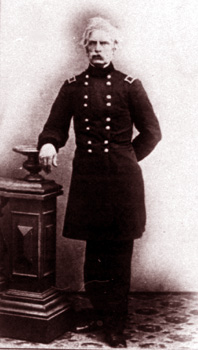Harvey Brown (officer) facts for kids
Quick facts for kids
Harvey Brown
|
|
|---|---|
 |
|
| Born | September 6, 1795 Rahway, New Jersey, United States |
| Died | March 31, 1874 (aged 78) Clifton, New York |
| Place of burial |
Hazelwood Cemetery
|
| Allegiance | Union |
| Service/ |
Union Army |
| Years of service | 1818–1867 |
| Rank | |
| Commands held | 5th United States Artillery |
| Battles/wars | Black Hawk War Seminole Wars Mexican–American War American Civil War |
| Relations | Harvey E. Brown, Jr. (son) |
Harvey Brown (born September 6, 1795 – died March 31, 1874) was an American army officer. He bravely fought in several important wars. These included the Black Hawk War, the Seminole Wars, and the Mexican–American War. He also served during the American Civil War.
Brown was in charge of military forces in New York City. He helped stop the New York Draft Riots in 1863. His son, Harvey E. Brown, Jr., also had a notable military career. He became a surgeon and later wrote about the history of the U.S. Army Medical Department.
Contents
Early Life and Military Start
Harvey E. Brown was born in Bridgetown, which is now part of Rahway, New Jersey. He studied at the United States Military Academy in West Point, New York. He graduated on July 24, 1818. He became a second lieutenant in the light artillery.
Brown's first years in the army involved different duties. He served at military posts in Boston, Massachusetts, and New London, Connecticut. He also worked in supply in St. Augustine, Florida. In 1821, the U.S. Army was reorganized. Brown joined the 1st United States Artillery. He was promoted to first lieutenant on August 28, 1821.
Serving Important Generals
From 1824 to 1825, Brown worked as an aide-de-camp. This means he was a personal assistant to Major General Jacob Brown. General Brown was the top commander of the U.S. Army at that time. Harvey Brown then spent three years working in supplies for the army.
In 1831, Brown became a captain. The next year, he fought in the Black Hawk War. He also took part in the Second Seminole War. He was a lieutenant colonel in this war. He fought in the Battle of Wahoo Swamp. For his brave actions on November 21, 1836, he was given a special rank of major. Between 1839 and 1841, he helped calm down problems along the Canada-US border.
Fighting in the Mexican-American War
During the Mexican–American War, Brown was a major. He served under famous Generals Zachary Taylor and Winfield Scott. He showed great skill in several battles. These included the Battle of Monterrey and the Battle of Cerro Gordo. He also fought in the Battle of Contreras.
His bravery was especially noted at the Gate of Belén. This was during the fall of Mexico City. For his actions in these last two battles, he earned special ranks. He became a lieutenant colonel and then a colonel. After the war, from 1848 to 1852, he helped recruit new soldiers. He then fought in the Third Seminole War in Florida until 1857. Before the American Civil War, Brown held various roles. He also inspected artillery.
Civil War Service
In January 1861, Harvey Brown was put in charge of military forces in Washington, D.C.. He also commanded Fort McHenry. He held these positions until the Civil War began four months later. He was first assigned to the 4th United States Artillery. He was offered a promotion to brigadier general but turned it down. Instead, he became the commanding officer of the new 5th United States Artillery on May 14, 1861.
Defending Fort Pickens
Brown was given an important mission. He was to lead an expedition to hold Fort Pickens. This fort was in Florida, which was then controlled by the Confederate states. He successfully defended Santa Rosa Island on October 9, 1861. He also stopped an enemy attempt to capture the fort on November 22–23, 1861.
For his brave actions at Fort Pickens, President Abraham Lincoln honored him. On April 25, 1862, Lincoln nominated Brown for a special rank. He became a brevet brigadier general in the regular army. This rank was effective from November 23, 1861. The United States Senate confirmed this on May 12, 1862.
Commanding in New York
In April 1862, Brown was made commander of New York Harbor. In January 1863, he became the full military commander of New York. He stayed in New York for over a year. During this time, the New York Draft Riots broke out. These were large protests against the military draft. Brown was in charge of the military operations against the rioters. He played a key role in finally stopping the riots.
Brown retired from active duty on August 1, 1863. On December 11, 1866, President Andrew Johnson nominated Brown for another special rank. He became a brevet major general in the regular army. This rank was effective from August 2, 1866. The United States Senate confirmed this on February 23, 1867.
Later Life
After his retirement, Brown waited for new orders from June 1864 to November 1866. He then served as the superintendent of the Army recruiting service. He held this role until April 5, 1867.
Harvey Brown passed away in Clifton, New York. He is buried in Hazelwood Cemetery in Rahway, New Jersey.

